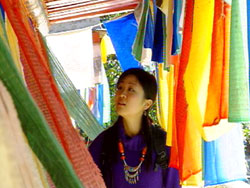Northwest Sichuan II --- Dege 
The main building is a 4-story complex with more than 30 rooms. Upstairs is where the printing is actually done. The workers work quickly and almost mechanically.
|

|
|
The workers work quickly and almost mechanically |
The printers use black and red ink to print two types of scriptures. The red ink they use to print are made of a medicinal herb with a low toxicity. That way, the paper repels mice and moths, and keeps them from damaging the books.
Besides scriptures on paper, the blueprints are also printed on cloth, creating prayer flags. There are some traditional designs, prayers, and pictures that are most commonly used and passed down from generation to generation.
These flags are not just for decoration. These are called prayer flags and that鈥檚 because on the flag are the scriptures. It is said each time the wind blows, it鈥檚 like reading the scriptures.
|

|
|
Prayer flags |
These prayer flags are hung outside homes. In my opinion, nothing is more beautiful than prayer flags fluttering in the wind, dancing in the light.
You might be wondering how and where these boards are made. Well, right across the street from the printing house. This man is making carvings on the board, which serve as the blueprint for future printings. The wedges here are all very deep, so they can last throughout time. Back in the old days, to encourage people to make deep wedges, the carvers would get paid based on how deep the wedges were. When the board was finished, a layer of gold dust would be spread on the surface and whatever fell into the wedges became the carver鈥檚 property.
The carvers first write the mirror image of the words onto the boards and then slowly carve out the inscriptions with a number of tools.
|

|
|
This is not as easy as I imagined |
This is not as easy as I imagined. You must apply as much pressure as needed or you get this. You don鈥檛 want that. You need nice smooth wedges.